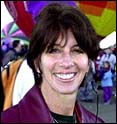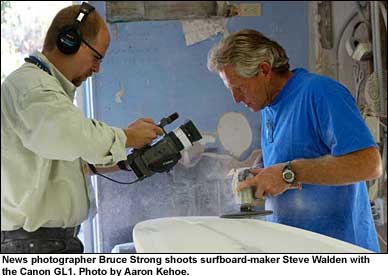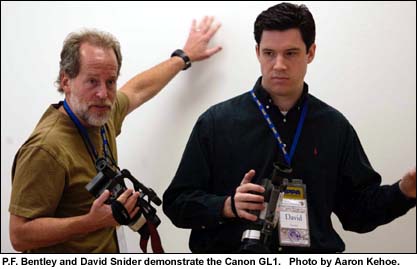Amy Bowers
TV Talk
If It Quacks Like a Dolphin
|

|
"It's so beautiful
here, we're all in bliss," said David Snider, from the Platypus
Workshop's new location on the Southern California coast.
The three best things
about the digital video storytelling workshop for still photographers
were: location, location, and location.

Dolphins played
in the waves at Ventura Beach, surfers bobbed in the soup and a guy
with a white poodle jogged by. At 7AM, surfboard maker Steve Walden
carried his board across the sand. Platypus participant Bruce Strong
videotaped a sequence with Walden, then went for a breakfast burrito
with workshop partner Jake Ford.
If this sunny scene were the only benefit of holding the Platypus Workshop
in California, it would have been enough. But there was also location
and location.
The new Ventura campus of the Brooks Institute of Photography couldn't
be better. The Plats were taught in a quiet classroom, worked in edit
bays in a large room comfortable space, and relaxed in a courtyard graced
with a fountain and lounge chairs. Across the parking lot they could
check out the Sound Stage where the film "Erin Brokovich"
was shot. Jim McNay, director of visual journalism at Brooks, provided
"care and feeding" for 28 participants and 5 faculty. When
he sent out for dinner, the Platypii dined on pizza with roasted sausage,
shitake mushrooms, sundried tomatoes, broccoli, and tostada toppings
(don't ask). The Pierpoint Inn & Racquet Club provided the digs,
nice ones.
The location, just south of Santa Barbara, was rich in subjects for
the video assignments. Unlike previous workshops in March in Norman
Oklahoma, on a campus abandoned during spring break, the area was filled
with art studios, acrobats and industrial areas that housed interesting
characters and commerce.
One such business attracted the "Strong-Ford" team. Jake Ford,
a student at BYU University, Hawaii, found the shop of Steve Walden,
known to surfers for his custom boards. Ford and Strong wandered into
the sun-splashed metal warehouse typical of businesses in Ventura Beach,
and introduced themselves to Walden, an easy-going but hard-working
wave-maven.
Applying techniques taught in presentations by Dirck Halstead and PF
Bentley, Strong looked around Walden Surfboards before shooting anything.
He asked Walden what he'd be doing that day and scouted the work areas.
Satisfied that the story elements were there, Bruce looked for a quiet
place to shoot an interview. He selected a small metal out-building
that had nice available light and a background that was descriptive
but not distracting. Concerned that Jake's familiarity with surfboards
could lead to a jargon-filled conversation, Bruce decided to conduct
the interview and let Jake shoot.
It was a good idea. Interviewing wasn't really that much of a stretch
for Bruce, who connects with his subjects in his still work for the
Orange County Register. Steve Walden talked about his surfboards, his
customers, his personal history and his love of surfing.
 Next,
the video team shot sequences of Steve "shaping" a board.
Bruce worked his shot selection: wide shot, close-up, different close-up,
medium, reverse. He shot scrapbook photos of Walden, and arranged to
meet Steve at the beach the next morning. Before the burritos plates
were washed, Bruce and Jake were in the edit bay, learning to use the
Final Cut Pro edit software. That evening, they cut their footage into
a one-minute piece. Next,
the video team shot sequences of Steve "shaping" a board.
Bruce worked his shot selection: wide shot, close-up, different close-up,
medium, reverse. He shot scrapbook photos of Walden, and arranged to
meet Steve at the beach the next morning. Before the burritos plates
were washed, Bruce and Jake were in the edit bay, learning to use the
Final Cut Pro edit software. That evening, they cut their footage into
a one-minute piece.
This year the workshop was streamlined by using simpler cameras requiring
less training time. Although some had never picked up a video camera,
the "shoot-and-edit" students quickly learned basic operation
of the 3-chip mini DV (digital video) Canon GL1. Michael Cutler, of
Canon USA in Irvine, California, provided tech support for the fifteen
shooters and their "producer" teammates. Final Cut Pro edit
software and G4 computers were available in the Brooks' Digital Video
Editing Lab.
There are lots of classes that teach video production, but Bruce Strong
chose Platypus because it's designed specifically for still photographers.
"Bruce Strong had been asking for three years, to go," said
Marcia Prouse, Director of Photography at the Orange County Register,
circ. 325,000, a flagship paper in the Freedom newspaper group. Strong,
a staff photographer at The Register for ten years, spent last year
as a Michigan Journalism Fellow and has a book to his credit with his
wife Claudia, "Armenia: The Story of a Place in Essays & Images."
Marcia Prouse isn't certain how and when video will be used at the Register,
but predicts her staff will not shoot both stills and video at the same
time. The Register, says Prouse, is known for its visual quality (staffers
are seldom given more than two assignments a day) and management will
need to allocate its resources to keep that quality in both stills and
video without increasing the staff. For those photographers who want
the opportunity to interview and report, "I believe in photographers
being empowered," says Prouse. She hopes that Strong, a leader
in his department, will be instrumental in training enough photographers
to shoot video on breaking news plus features.
Ken Brusic, Head of Content for Freedom Orange County Information group,
confirms Prouse's enthusiasm. Brusic says the Register was an early
convert to digital imaging prompting a "near revolt in the newsroom."
Today the paper is 95% digital and is building its business as an information
company. It has a website and a portal. Daily news has a short shelf-life,
but the research and databases behind the paper edition can be marketed,
according to Brusic. Information already collected for the papers and
magazines will be a commodity for Freedom Group.
"I've been to a lot of newspaper conventions," says Brusic.
He acknowledges that industry is weathering tough times, but expects
to "turn that around and look at the opportunities." The Orange
County readership is a changing demographic. As it shifts from all white
to significantly Hispanic and Asian, Freedom group will concentrate
on identifying the needs of its readers. The Register will address those
needs, in print and online, and in stand-alone information booklets,
says Brusic. Revenue from partnerships will extend to "almost anything
you can think of."
When that revenue starts streaming, says Dirck Halstead, and "that
pipeline finally opens, the market for personal storytelling will take
off." Halstead has made a career of training and nurturing established
photographers like David and Peter Turnley, Don Doll SJ, PF Bentley,
and David Snider, all of whom went on to produce programs for Nightline
on ABC News.
 Faculty
member PF Bentley, known for his expressive insider photography on Capitol
Hill, screened two cuts of the Tom Daschle story he produced for Nightline.
The Nightline cut was reported by correspondent Chris Bury. PF's personal
cut was told without narrator or reporter. Faculty
member PF Bentley, known for his expressive insider photography on Capitol
Hill, screened two cuts of the Tom Daschle story he produced for Nightline.
The Nightline cut was reported by correspondent Chris Bury. PF's personal
cut was told without narrator or reporter.
Not all Platypii produce for Big Time Television. Faculty member Roger
Richards, graduate of the 1999 workshop and Washington Times veteran,
is based in Newport News, Virginia. In an evening presentation at Brooks,
he told workshop participants, "Think small, think forward."
His Digital Filmmaker site
showcases his beautiful videos "Seven Lilies" and "Sarajevo
Roses" shot in the Balkans. Richards encourages photojournalists
to make videos that are short enough to stream. If you stream them,
they will come?
David Snider is a shooter and storyteller, a kid with a video camera,
a photographer with a voice. First comes his vision, later comes television.
Snider said his interest in people led to a handful of shows for Nightline
and several works in progress. He screened a story about a baseball
program for children in the Dominican Republic. In one scene, a coach
explains that a group of girls asked if they could play. The coach says
he told them he might develop a program the following year. The girls,
says the coach, persisted: How about tomorrow? Cut to: an enormous group
of girls, laughing, walking chatting across a field. Voice over, by
coach, "The next day, 350 girls showed up." The coaches use
Snider's baseball show as a fundraising video. David says he'll work
on another cut and market it.
Snider's other work in progress is the story of a boxer named Beethavean
Scottland. Using a digital video camera lent to him by Dirck Halstead,
he shot tape of Bee in 1997. Four years later, the same boxer was knocked
unconscious in the ring and died of his injuries. David contributed
his extraordinary footage, including an interview with Bee predicting
his own death in the ring, and helped produce a Nightline story reported
by Dave Marash. Snider continues to work on his expanded version of
the story.
After the 2002 workshop at Brooks, Snider wrote, "this workshop
was the best we've ever done. The vibe was great and lots of hard work
resulted in 15 shooters with finished pieces in Final Cut Pro. We were
astonished at how good everything went. We also had demonstrations and
discussions on video lighting for interviews, equipment choices, ethics,
web compression, and making a living out of this."
Fifteen photojournalists and their partners were released into the world.
As usual, no one knows where and how they'll apply their talent. As
always, it will expand into the world, on the web, over the cable and
through the woods. Stay tuned.
Amy Bowers
Contributing Writer
amy@marash.tv
|


 Next,
the video team shot sequences of Steve "shaping" a board.
Bruce worked his shot selection: wide shot, close-up, different close-up,
medium, reverse. He shot scrapbook photos of Walden, and arranged to
meet Steve at the beach the next morning. Before the burritos plates
were washed, Bruce and Jake were in the edit bay, learning to use the
Final Cut Pro edit software. That evening, they cut their footage into
a one-minute piece.
Next,
the video team shot sequences of Steve "shaping" a board.
Bruce worked his shot selection: wide shot, close-up, different close-up,
medium, reverse. He shot scrapbook photos of Walden, and arranged to
meet Steve at the beach the next morning. Before the burritos plates
were washed, Bruce and Jake were in the edit bay, learning to use the
Final Cut Pro edit software. That evening, they cut their footage into
a one-minute piece.  Faculty
member PF Bentley, known for his expressive insider photography on Capitol
Hill, screened two cuts of the Tom Daschle story he produced for Nightline.
The Nightline cut was reported by correspondent Chris Bury. PF's personal
cut was told without narrator or reporter.
Faculty
member PF Bentley, known for his expressive insider photography on Capitol
Hill, screened two cuts of the Tom Daschle story he produced for Nightline.
The Nightline cut was reported by correspondent Chris Bury. PF's personal
cut was told without narrator or reporter.